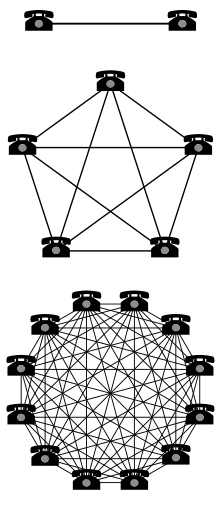Metcalfe's law

Metcalfe's law states that the value of a telecommunications network is proportional to the square of the number of connected users of the system (n2). First formulated in this form by George Gilder in 1993,[1] and attributed to Robert Metcalfe in regard to Ethernet, Metcalfe's law was originally presented, circa 1980, not in terms of users, but rather of "compatible communicating devices" (for example, fax machines, telephones, etc.)[2] Only more recently with the launch of the Internet did this law carry over to users and networks as its original intent was to describe Ethernet purchases and connections.[3] The law is also very much related to economics and business management, especially with competitive companies looking to merge with one another.
Network effects
Metcalfe's law characterizes many of the network effects of communication technologies and networks such as the Internet, social networking, and the World Wide Web. Former Chairman of the U.S. Federal Communications Commission, Reed Hundt, said that this law gives the most understanding to the workings of the Internet.[4] Metcalfe's Law is related to the fact that the number of unique connections in a network of a number of nodes (n) can be expressed mathematically as the triangular number n(n − 1)/2, which is proportional to n2 asymptotically.
The law has often been illustrated using the example of fax machines: a single fax machine is useless, but the value of every fax machine increases with the total number of fax machines in the network, because the total number of people with whom each user may send and receive documents increases.[5] Likewise, in social networks, the greater number of users with the service, the more valuable the service becomes to the community.
Limitations
In addition to the difficulty of quantifying the "value" of a network, the mathematical justification for Metcalfe's law measures only the potential number of contacts, i.e., the technological side of a network. However the social utility of a network depends upon the number of nodes in contact. If there are language barriers or other reasons why large parts of a network are not in contact with other parts, the effect may be smaller.
Business practicalities
With Metcalfe's Law the way it is described, all companies would theoretically combine with another partner. This would create more users involved in the company both on a consumer and supplier basis. This is not the case however. Much of the time, only companies of equal equity are willing to interconnect with one another. In the case of a larger network or business, and a smaller network or business, the larger feels the smaller one is benefiting on a much larger scale. The larger business gains little in comparison to the small company as the large has already developed a reputation whereas the small company is feeding off their previous success.[6]
Modified models
Within the context of social networks, many, including Metcalfe himself, have proposed modified models using (n × log n) proportionality rather than n2 proportionality.[7] Reed and Odlyzko have sought out possible relationships to Metcalfe's Law in terms of describing the relationship of a network and one can read about how those are related.[8]
See also
- Simplex
- List of eponymous laws
- The generalized network effect of microeconomics.
- Reed's law
- Sarnoff's law
- Beckstrom's Law
- social media
References
- ^ Carl Shapiro and Hal R. Varian (1999). Information Rules. Harvard Business Press. ISBN 0-87584-863-X.
- ^ Simeon Simeonov (July 26, 2006). "Metcalfe's Law: more misunderstood than wrong?". HighContrast: Innovation & venture capital in the post-broadband era.
- ^ James Hendler and Jennifer Golbeck (2008). "Metcalfe's Law, Web 2.0, and the Semantic Web" (PDF).
{{cite web}}: CS1 maint: numeric names: authors list (link) - ^ Bob Briscoe (July 2006). "Metcalfe's Law is wrong". Retrieved 2010-07-25.
- ^ R. Tongia. "The Dark Side of Metcalfe's Law: Multiple and Growing Costs of Network Exclusion" (PDF). Retrieved 2010-07-25.
- ^ Steven Shankland (15 March 2005). "Researchers: Metcalfe's Law overshoots the mark". Retrieved 2010-07-25.
- ^ "Guest Blogger Bob Metcalfe: Metcalfe's Law Recurses Down the Long Tail of Social Networks". 18 August 2006. Retrieved 2010-06-20.
- ^ Rahul Tongia (September 2007). "TURNING METCALFE ON HIS HEAD: THE MULTIPLE COSTS OF NETWORK EXCLUSION" (PDF). Retrieved 2010-07-25.
External links
- Metcalfe's Law: More Misunderstood Than Wrong?. A co-worker of Bob Metcalfe puts the IEEE Spectrum critique in perspective. Republished here.
- Metcalfe's Law is Wrong. Bob Briscoe, Andrew Odlyzko, and Benjamin Tilly, July 2006 IEEE Spectrum. Points out that Metcalfe's Law is wrong, that the value is closer to n log (n)
- Metcalfe’s Law Recurses Down the Long Tail of Social Networking by Bob Metcalfe
- ZDNet: Metcalfe's Law overshoots the mark
- Andrew Odlyzko and Benjamin Tilly paper
- Metcalfe's Law in Reverse, applying Metcalfe's law to form an argument in favour of large, unified networks.
- George Church. The Personal Genome Project. Molecular Systems Biology. 13 December 2005
- The Semantic Web and Metcalfe's Law
- A Group Is Its Own Worst Enemy. Clay Shirky's keynote speech on Social Software at the O'Reilly Emerging Technology conference, Santa Clara, April 24, 2003. The fourth of his "Four Things to Design For" is: "And, finally, you have to find a way to spare the group from scale. Scale alone kills conversations, because conversations require dense two-way conversations. In conversational contexts, Metcalfe's law is a drag."
- How Many Facebook Friends Does Someone Need.
- The Dark Side of Metcalfe's Law.
- Globalization Transformation.
